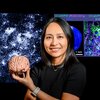
Contact Information
407 S Goodwin Ave
Urbana IL 61801
Research Areas
Research Description
Exploring Astrocyte Contributions to Neural Circuits, Behaviors and Diseases
Our emotions and thoughts are generated and processed by a network of different cell types in the brain, including both neurons and glial cells. As the most abundant glial cells, the "star cells" - astrocytes - were discovered more than a century ago but were only considered to have passive supporting functions to neurons. However, many recent studies have challenged this view and suggested that astrocytes are an integral part of the central nervous system.
There are two major questions that we are interested in:
- What are the cellular and molecular mechanisms by which astrocytes contribute to neural circuit plasticity, motor learning and memory, and the development of neuropsychiatric disorders?
- How can we link and predict circuit and behavioral alterations based on astrocyte signaling changes?
To tackle these questions, we will take a systematic approach with innovative genetic tools, in vivo imaging, electrophysiological recordings, next generation sequencing and computational modeling. We hope that our findings will expand the understanding of astrocyte physiology as well as offer mechanistic insights into new biomarkers for early diagnosis and potential therapeutic treatments for neuropsychiatric disorders.
Education
B.S., Tsinghua University, Beijing, China
M.S., Tsinghua University, Beijing, China
Ph.D., University of California Santa Cruz
Postdoc., University of California Santa Cruz
Postdoc., University of California Los Angeles
Awards and Honors
2019 NIH BRAIN Initiative Principal Investigators Meeting Travel Award, National Institutes of Health
2018 – 2019 Brain Research Institute Postdoctoral Award, University of California Los Angeles
2016 – 2017 American Heart Association Postdoctoral Fellowship, American Heart Association
Additional Campus Affiliations
External Links
Highlighted Publications
Yu X*, Nagai J*, Marti-Solano M, Soto JS, Coppola G, Babu MM and Khakh BS (2020) Context-specific striatal astrocyte molecular responses are phenotypically exploitable. Neuron. 2020 Oct 9:S0896-6273(20)30745-5. (* Equal contribution)
Yu X*, Nagai J* and Khakh BS (2020) Improved tools to study astrocytes. Nature Reviews Neuroscience. 2020 Mar;21(3):121-138. (* Equal contribution)
Yu X, Taylor AMW, Nagai J, Golshani P, Evans CJ, Coppola G and Khakh BS (2018) Reducing astrocyte calcium signaling in vivo alters striatal microcircuits and causes repetitive behavior. Neuron. 99(6):1170-1187
Hodges JL*, Yu X*, Gilmore A, Bennett H, Tjia M, Perna JF, Chen CC, Li X, Lu J and Zuo Y (2017) Astrocytic contributions to synaptic and learning abnormalities in a mouse model of Fragile X Syndrome. Biological Psychiatry. 82(2): 139-149. (* Equal contribution)
Yu X, Wang G, Gilmore A, Yee AX, Li X, Xu T, Smith SJ, Chen L and Zuo Y (2013) Accelerated experience-dependent pruning of cortical synapses in ephrin-A2 knockout mice. Neuron. 80(1):64-71.
Fu M, Yu X, Lu J and Zuo Y (2012) Repetitive motor learning induces coordinated formation of clustered dendritic spines in vivo. Nature. 483(7387):92-5.
Yu X, Zuo Y (2011) Spine plasticity in the motor cortex. Current Opinion in Neurobiology. 21(1):169-74.
Xu T*, Yu X*, Perlik A, Tobin W, Zweig J and Zuo Y (2009) Rapid formation and selective stabilization of synapses for enduring motor memories. Nature. 462(7275):915-9. (* Equal contribution)
Recent Publications
Iyer, M., Kantarci, H., Cooper, M. H., Ambiel, N., Novak, S. W., Andrade, L. R., Lam, M., Jones, G., Münch, A. E., Yu, X., Khakh, B. S., Manor, U., & Zuchero, J. B. (2024). Oligodendrocyte calcium signaling promotes actin-dependent myelin sheath extension. Nature communications, 15(1), Article 265. https://doi.org/10.1038/s41467-023-44238-3
Yook, Y., Lee, K. Y., Kim, E., Lizarazo, S., Yu, X., & Tsai, N. P. (2024). Hyperfunction of post-synaptic density protein 95 promotes seizure response in early-stage aβ pathology. EMBO Reports, 25(3), 1233-1255. https://doi.org/10.1038/s44319-024-00090-0
Phi, N. T., Yu, X., & Hong, W. (2023). Control of social hierarchy beyond neurons. Nature Neuroscience, 26(9), 1485-1486. https://doi.org/10.1038/s41593-023-01392-7
Cho, F. S., Vainchtein, I. D., Voskobiynyk, Y., Morningstar, A. R., Aparicio, F., Higashikubo, B., Ciesielska, A., Broekaart, D. W. M., Anink, J. J., van Vliet, E. A., Yu, X., Khakh, B. S., Aronica, E., Molofsky, A. V., & Paz, J. T. (2022). Enhancing GAT-3 in thalamic astrocytes promotes resilience to brain injury in rodents. Science Translational Medicine, 14(652), Article eabj4310. https://doi.org/10.1126/scitranslmed.abj4310
Endo, F., Kasai, A., Soto, J. S., Yu, X., Qu, Z., Hashimoto, H., Gradinaru, V., Kawaguchi, R., & Khakh, B. S. (2022). Molecular basis of astrocyte diversity and morphology across the CNS in health and disease. Science, 378(6619), Article eadc9020. https://doi.org/10.1126/science.adc9020

